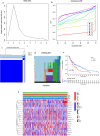Development and validation of a ferroptosis-related lncRNAs signature to predict prognosis and microenvironment for melanoma
- PMID: 36371574
- PMCID: PMC9653531
- DOI: 10.1007/s12672-022-00581-3
Development and validation of a ferroptosis-related lncRNAs signature to predict prognosis and microenvironment for melanoma
Abstract
Ferroptosis plays an important role in cancer. However, studies about ferroptosis-related lncRNAs (FRLs) in skin cutaneous melanoma (SKCM) are scarce. Moreover, the relationship between prognostic FRLs and tumor microenvironment (TME) in melanoma remains unclear. This study investigates the potential prognostic value of FRLs and their association with TME in SKCM. The RNA-sequencing data of SKCM were downloaded from The Cancer Genome Atlas (TCGA) database. Melanoma patients were randomly divided into training and testing groups in a 1:1 ratio. A signature composed of 19 FRLs was developed by the least absolute shrinkage and selection operator (LASSO) regression analysis to divide patients into a low-risk group with a better prognosis and a high-risk group with a poor prognosis. Multivariate Cox regression analysis suggested that the risk score was an independent prognostic factor. The Area Under Curve (AUC) value of the risk score reached 0.768 in the training group and 0.770 in the testing group. Subsequent analysis proved that immune-related signaling pathways were significantly enriched in the low-risk group. The tumor immune cell infiltration analysis demonstrated that melanoma in the high-risk group tended to be immunologically "cold". We identified a novel FRLs signature which could accurately predict the prognosis of patients with melanoma.
Keywords: Ferroptosis; Melanoma; Prognosis; Tumor microenvironment; lncRNA.
© 2022. The Author(s).
Conflict of interest statement
The authors declare no conflicts of interest in this work.
Figures








Similar articles
-
Development and validation of ferroptosis-related lncRNA signature and immune-related gene signature for predicting the prognosis of cutaneous melanoma patients.Apoptosis. 2023 Jun;28(5-6):840-859. doi: 10.1007/s10495-023-01831-7. Epub 2023 Mar 24. Apoptosis. 2023. PMID: 36964478
-
Development and Validation of a Novel Ferroptosis-Related LncRNA Signature for Predicting Prognosis and the Immune Landscape Features in Uveal Melanoma.Front Immunol. 2022 Jun 14;13:922315. doi: 10.3389/fimmu.2022.922315. eCollection 2022. Front Immunol. 2022. PMID: 35774794 Free PMC article.
-
Construction of a ferroptosis-related signature based on seven lncRNAs for prognosis and immune landscape in clear cell renal cell carcinoma.BMC Med Genomics. 2022 Dec 17;15(1):263. doi: 10.1186/s12920-022-01418-2. BMC Med Genomics. 2022. PMID: 36528763 Free PMC article.
-
Construction of a ferroptosis-related five-lncRNA signature for predicting prognosis and immune response in thyroid carcinoma.Cancer Cell Int. 2022 Sep 29;22(1):296. doi: 10.1186/s12935-022-02674-z. Cancer Cell Int. 2022. PMID: 36175889 Free PMC article.
-
A Ferroptosis-Related lncRNAs Signature Predicts Prognosis and Immune Microenvironment for Breast Cancer.Front Mol Biosci. 2021 Jun 7;8:678877. doi: 10.3389/fmolb.2021.678877. eCollection 2021. Front Mol Biosci. 2021. PMID: 34164433 Free PMC article.
Cited by
-
Involvement of transcribed lncRNA uc.291 in hyperproliferative skin disorders.Biol Direct. 2023 Dec 1;18(1):82. doi: 10.1186/s13062-023-00435-0. Biol Direct. 2023. PMID: 38041107 Free PMC article.
-
EGFR influences the resistance to targeted therapy in BRAF V600E melanomas by regulating the ferroptosis process.Arch Dermatol Res. 2025 Mar 1;317(1):514. doi: 10.1007/s00403-025-03895-8. Arch Dermatol Res. 2025. PMID: 40024937 Free PMC article.
-
Development and validation of ferroptosis-related lncRNA signature and immune-related gene signature for predicting the prognosis of cutaneous melanoma patients.Apoptosis. 2023 Jun;28(5-6):840-859. doi: 10.1007/s10495-023-01831-7. Epub 2023 Mar 24. Apoptosis. 2023. PMID: 36964478
-
Hyaluronic acid metabolism and chemotherapy resistance: recent advances and therapeutic potential.Mol Oncol. 2024 Sep;18(9):2087-2106. doi: 10.1002/1878-0261.13551. Epub 2024 Mar 21. Mol Oncol. 2024. PMID: 37953485 Free PMC article. Review.
-
The role of non-coding RNAs in the regulation of cell death pathways in melanoma.Discov Oncol. 2025 Jun 11;16(1):1063. doi: 10.1007/s12672-025-02888-3. Discov Oncol. 2025. PMID: 40500552 Free PMC article. Review.
References
-
- Roszik J, Markovits E, Dobosz P, Layani A, Slabodnik-Kaner K, Baruch EN, Ben-Betzalel G, Grimm E, Berger R, Sidi Y, et al. TNFSF4 (OX40L) expression and survival in locally advanced and metastatic melanoma. Cancer Immunol Immunother CII. 2019;68:1493–1500. doi: 10.1007/s00262-019-02382-0. - DOI - PMC - PubMed
LinkOut - more resources
Full Text Sources
